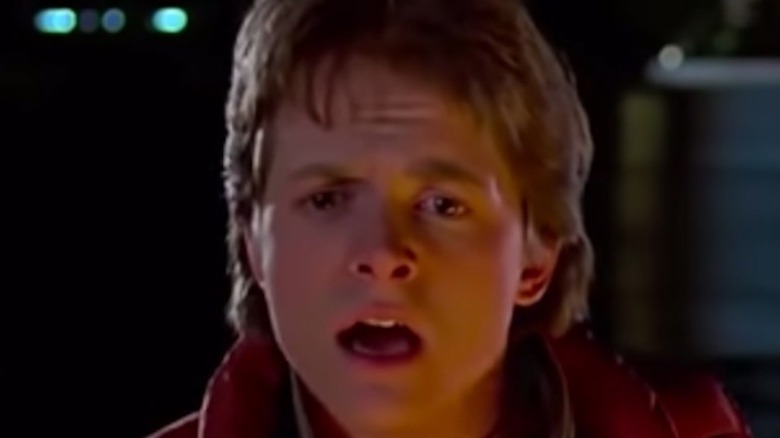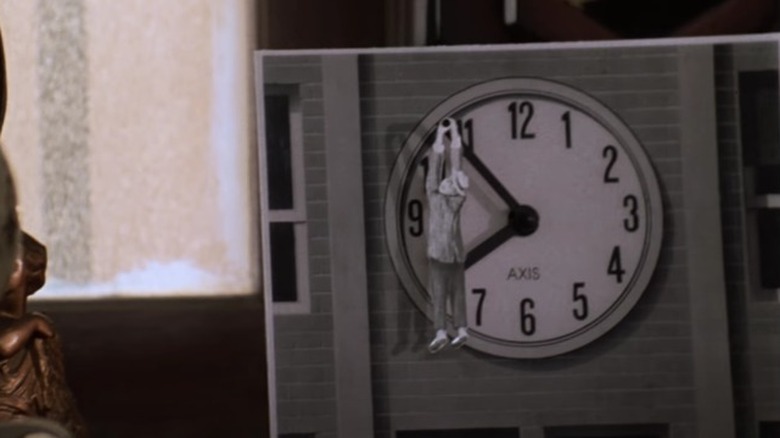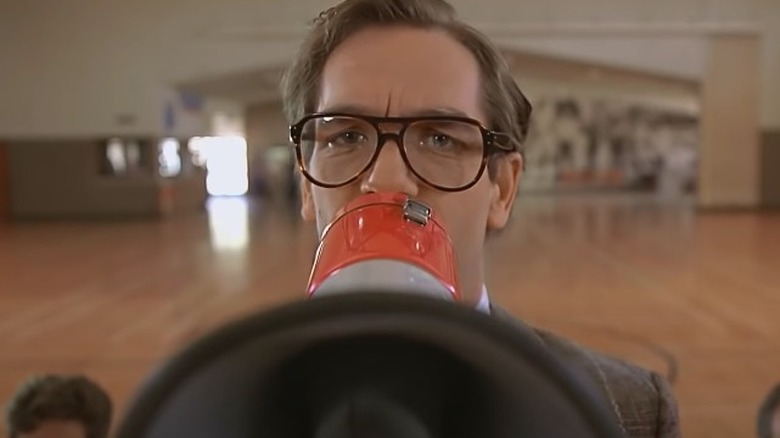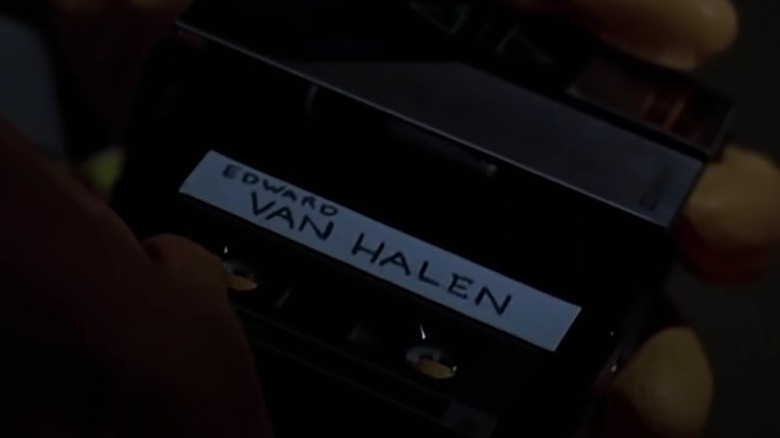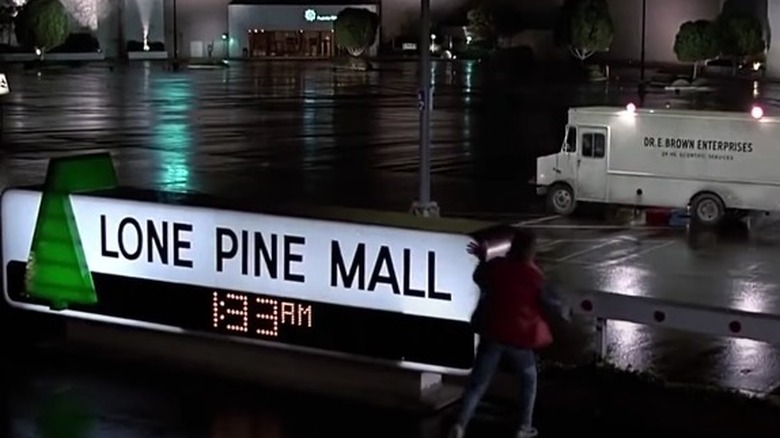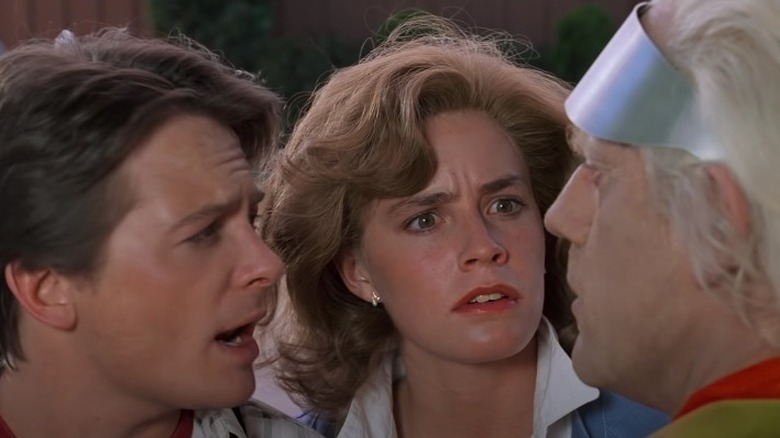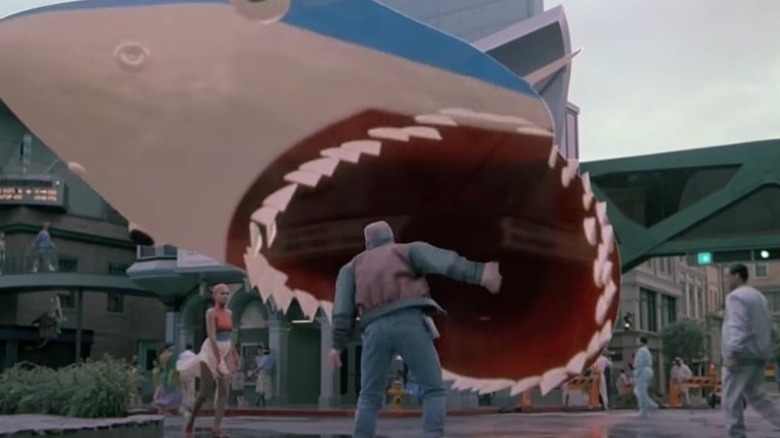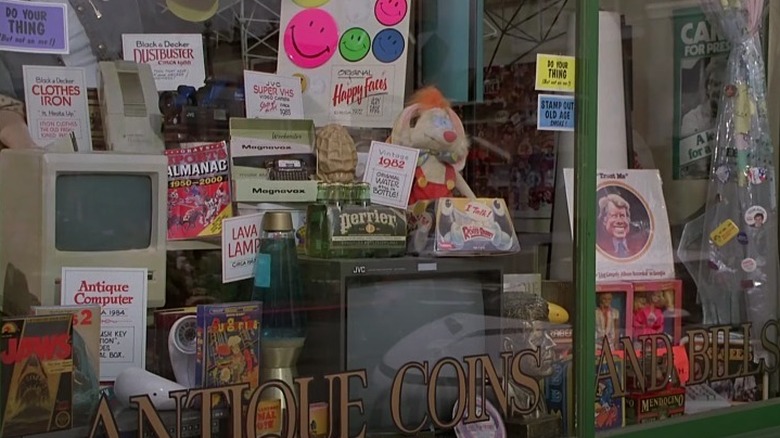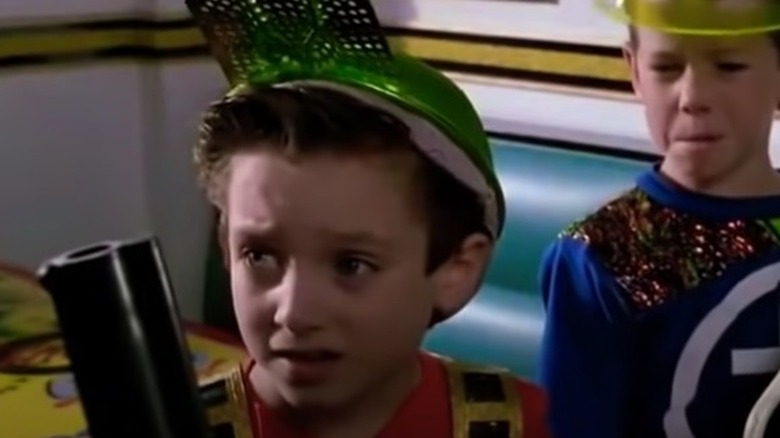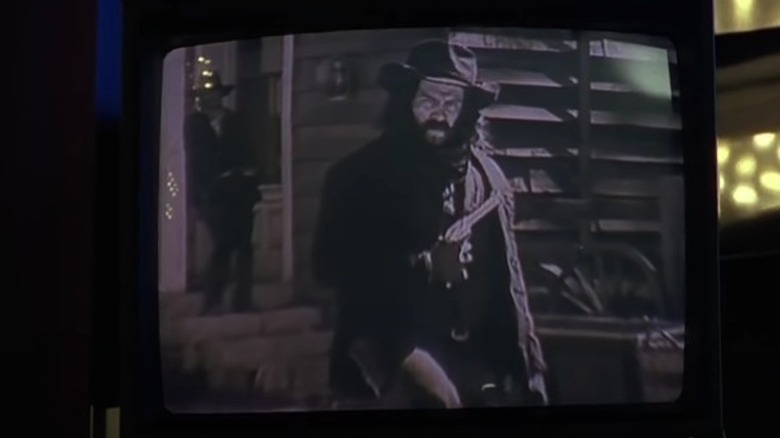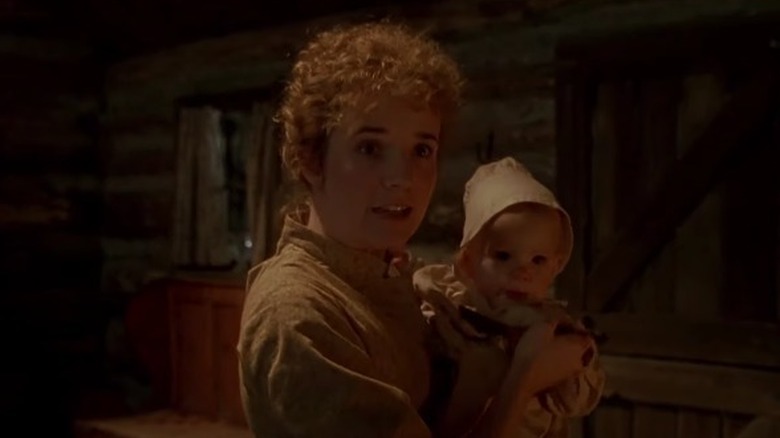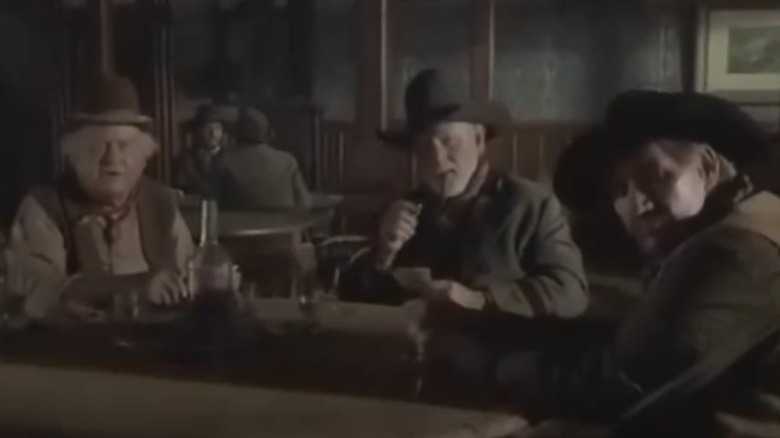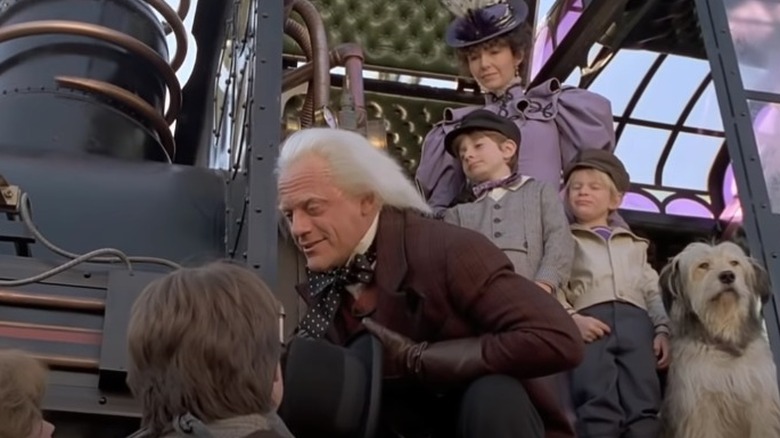The Most Paused Moments In The Back To The Future Trilogy
The "Back to the Future" films are one of the greatest trilogies in all of Hollywood history. The story of Marty McFly's adventures to the past and future has been dazzling audiences since the original's release on July 3, 1985. From the time-traveling DeLorean to quotes like "This is heavy" and Doc Brown's exclamation "Great Scott!", nearly every single element of the sci-fi adventure comedy has become a classic.
Lovingly made by writer-director Robert Zemeckis and co-creator Bob Gale, the films are packed with foreshadowing, setups, and payoffs that have kept fans busy poring over every detail for decades. Many of the moments discussed by the most die-hard "Back to the Future" fans are of the "blink and you'll miss it" variety, requiring people to pause the film to notice them. With that said, we've decided to take a look at the most paused moments in the "Back to the Future" trilogy.
All those clocks
The opening scene in "Back to the Future" tells you pretty much everything you need to know about the film without exactly telegraphing it. For one thing, if the title didn't give it away already, seeing all those clocks makes it perfectly clear that this is a film about time. Not only that but mixed in with the time-keepers is a framed newspaper clipping that gives us a bit of backstory about Doc's mansion getting destroyed; the video camera that will be used later to prove that Marty is from the future; TV news discussing a story about a terrorist group stealing plutonium; and gadgets that show us that this is the home of an inventor. In addition, the plutonium revealed by Marty's skateboard lets us know that he's dealing in dangerous business, and his absence tells us he's a little flaky.
As fascinating as that all is, the item that sticks out the most upon rewatch is the artistic rendering of a man hanging from a clock face. Given the figure's clothing and glasses, this is an obvious reference to the 1923 silent comedy "Safety Last!" starring Harold Lloyd. In that film, Lloyd dangles over the city from a clock. This also mirrors the end of "Back to the Future," where Doc Brown climbs the clock tower to harness an energy bolt and send Marty back to the future. Another nice coincidence is the last names of the two actors — Doc Brown is played by Christopher Lloyd.
Is that who I think it is?
The week that "Back to the Future" came out, the song "Power of Love" by Huey Lewis and the News was No. 35 on the Billboard Hot 100. The song also featured prominently in the film's opening depicting Marty McFly's attempt to get to school late without getting caught. Later on, when Marty and his band are auditioning to play at the school dance, the band plays an even louder version of the song. In fact, they play it so loud that Huey Lewis himself tells them, "I'm afraid you're just too darn loud."
The song was written specifically for the film — as was "Back In Time" — but as Lewis explained to USA Today, the collaboration between his band and the film almost didn't happen. "I said, 'I'm flattered, but I don't know how to write for film.' Plus, I didn't fancy writing a song called 'Back to the Future.'" Luckily the filmmakers changed his mind, and he ended up doing a cameo as well.
Van Halen
Getting trapped in the past means that Marty screwed up the future. He stopped his father, George McFly, from meeting and falling in love with his mother Lorraine, effectively erasing his future self from existence. So Marty's in a race against time to get his parents together and save his life.
When young George (played by Crispin Glover) refuses to step out of his comfort zone, Marty resorts to appealing to his nerdy father's sci-fi obsession. He dresses up as an alien named Darth Vader, who is visiting him from the planet Vulcan. To prove his extraterrestrial status, Marty blasts face-melting, Van Halen guitar solos in his ears. Only, the cassette tape he put in his Walkman doesn't just say Van Halen. It says, "Edward Van Halen."
Edward Van Halen is, of course, guitarist Eddie Van Halen. According to the audio commentary for the film, the rest of the band didn't want to be associated with the film. Instead, they could only use Eddie's solos. The riffs shredding George's eardrums weren't from any Van Halen song, however, and the guitarist clarified to TMZ in 2012 that the audio used in the film was him "just playing a bunch of noise."
How many Pines are there anyway?
The inciting incident and the climax of "Back to the Future" both take place in the same location. During the first act, when Doc Brown reveals his time machine to Marty, they are at the Twin Pines Mall. Everything's going just fine until terrorists show up and start shooting up the place. Doc is killed in the chaos, and Marty accidentally sends himself back to 1955. In the insanity of the moment, Marty finds himself driving through an old man's backyard. Later, when Marty finds his way back to the future, the mall is now called Lone Pine Mall.
Hopefully, most audience members were too wrapped up in the excitement of the film to be distracted by this change, but upon repeat viewings, the difference is clear. The explanation as to how this happened also requires multiple viewings, but it's perfectly clear. That old man's yard? Turns out he was someone named Old Man Peabody, and Doc Brown mentions him before the terrorists show up. The Doc mentions that Old Man Peabody "had this crazy idea about breeding pine trees."
In Marty's haste to flee from Old Man Peabody's property, he slams through one of the twin pines the old man had fenced off. Since there's only one left, it's a lone pine. Bonus Easter egg: In the credits, Peabody's son's name is Sherman. This must be a reference to the classic animated time-travelers Mr. Peabody and Sherman from "Rocky and His Friends."
Where's Jennifer?
If Marty McFly is the frustrated rockstar living with square parents and a fear of rejection, his girlfriend Jennifer is the lightning rod of inspiration he needs to do something with his life. She looks out for him and supports him in ways his family doesn't. As we learn later in the film, his father, George, never really had the guts to do anything with his writing, and Marty's afraid to pursue his music. Jennifer's the one who reminds him of how great he is.
While not a huge part of the original film, Jennifer's role in Marty's life is important. So it makes sense that the character carried over for the sequel. However, when audiences turned up to see the film in November of 1989, a different Jennifer was there with Marty. This time, instead of Claudia Wells, '80s staple Elisabeth Shue stepped in to play the part. Younger audience members may not have noticed the change at first but were likely surprised during a revisit.
Wells has discussed her absence before. She told People that dealing with her mother's illness at the time became her top priority, saying, "I just wasn't in a place to be able to think about my career or the film or anything other than what I was doing with my own life."
Too many Jawses
"Back to the Future Part II" is crammed with all sorts of fun and interesting details. Most of this list could be devoted to this film alone, and one of the more obvious and memorable in-jokes comes in the form of a giant holographic shark.
When Marty arrives in the Hill Valley of 2015, the world is a dazzling place. Cars fly, people wear weird clothes, the buildings have been updated, and there are actual holograms instead of billboards. As Marty walks the streets looking for the Cafe '80s, he is suddenly accosted by a humungous shark rising from a marquee, opening its jaws really wide and bearing down on the time traveler. Once those immense jaws close, the shark disappears, and Marty realizes it's just an ad for yet another "Jaws" sequel. While it's pretty clear, some audiences distracted by their laughter might not have noticed that the sequel being advertised is "Jaws 19."
'80s nostalgia galore
Although the real 2015 didn't exactly resemble the one depicted in the film, it did manage to predict a few things that actually came to pass. For one thing, the 21st century's obsession with '80s nostalgia was right on the money. Between shows like "Everybody Hates Chris," "The Goldbergs," and "Stranger Things" – and all the reboots and sequels based on '80s franchises that followed later — it's fair to say that a fondness for Marty's decade is alive and well in the real world.
This yearning for the past is demonstrated through Cafe '80s and the antique store Blast from the Past. The store serves a narrative purpose, as this is where Marty purchases the almanac that Biff uses to go back in time and make himself rich. But it's also just fun for modern audiences to pause and skim through all the different merchandise on display in the store's window.
Is that Frodo?
Prior to the events of "Back to the Future Part III," it's established that Marty is a good shot. When waiting at the Cafe '80s, he spies some kids playing an old Western shooting game. As the kids struggle to figure the game out, Marty steps up to show 'em how it's done. Their response to his gaming skills is priceless as one of them says, "You mean you have to use your hands? That's like a baby's toy."
Modern audiences watching the trilogy for the first time might be surprised to see an alum from another great trilogy — "Lord of the Rings" – playing the kid in the green hat. Yes, that is Elijah Wood, Frodo Baggins himself, in his first credited screen role. Wood, who loved the original "Back to the Future," told Deadline that working on the film changed his perspective of movies. "It took what I understood about cinema and put it into this very real realm," he said. He went on to say that being in something related to what he had watched growing up was "completely mind-blowing." He credits the film with showing him that making movies is something you can do with your life.
Past things to come
Another glimpse at Marty's future — which will happen in the past — comes in the form of a little documentary video detailing the rise of Biff Tannen. After Marty purchases the almanac, Doc scolds him, saying that he didn't invent the time machine for financial gain. The almanac is left in the trash to be fished out by an elderly and bitter Biff Tannen. He then steals the DeLorean, goes back in time, and gives the almanac to his younger self. Young Biff then uses this information to make money betting on sporting events.
This results in a nightmarish alternate version of 1985 where Biff is in charge of everything and Hill Valley has become a hellscape. When Marty arrives in this alternate timeline, he sees a mini-documentary detailing Tannen's rise to power. They also mention his great grandfather Buford "Mad Dog" Tannen, whom they dub the "fastest gun in the West." When watching this for the first time, you're probably too overwhelmed by the chaos going on to realize that you meet "Mad Dog" himself in the next movie. On your next watch, however, the foreshadowing is crystal clear.
Are the McFly's inbred?
At some point, while working on the "Back to the Future" sequels, it was decided that the original actors would also play their family members. In "Back to the Future Part II," you have Thomas Wilson play Biff and his grandson, as well as appearing in an image as Buford Tannen. Then there's Michael J. Fox playing Marty's kids. When Marty travels back to 1885, it makes sense to have Michael J. Fox play his own great-great-grandfather Seamus. But why is Lea Thompson playing his great-great-grandmother, Maggie?
The strangeness of this may not hit you right away, but when it does, you'll have to pause the movie to consider the implications. Based on the rules established in the previous film, descendants of certain characters tend to resemble their ancestors. If Lea Thompson plays both Maggie McFly and Lorraine Baines (who would later get married to George McFly), does this mean that Lorraine and George are related?
There's a quote attributed to co-creator Bob Gale explaining both the behind-the-scenes reasoning and in-world explanation. Really, it just boils down to a fun callback to scenes of Marty waking up to Lea Thompson's voice in the previous movies, and you just need to go with it. "Lea plays Maggie because we didn't want to make a 'Back to the Future Part III' without having Lea in it, especially in a 'Mom is that you' scene!" he said. "It's a well-known adage that 'men are attracted to women who remind them of their mothers,'" he later added for the in-world explanation.
Hollywood's Old West
The third film in the "Back to the Future" trilogy sees Marty heading back to the origins of Hill Valley and the Old West in 1885. Just as Hill Valley's town square looks remarkably like the Universal Studios lot, the burgeoning town from the past resembles a classic Hollywood Old West town. In what almost appears to be a wink to this, the saloon is inhabited by three men played by former stars of classic Westerns — Dub Taylor, Pat Buttram, and Harry Carey Jr.
Dub Taylor appeared in a slew of westerns during the '40s and '50s. He was also in "Bonnie and Clyde" in 1967 and "The Wild Bunch" in 1969. If you don't recognize Pat Buttram's face from all the movies and TV appearances from the '50s and '60s, you certainly recognize his voice as Napoleon in "The Aristocrats" or the Sheriff of Nottingham in Disney's "Robin Hood." Harry Carey Jr. also appeared in several Westerns from the same time period, as well as the more recent Western "Tombstone" from 1993 and another Amblin classic "Gremlins."
Does Doc's kid need a bathroom break?
During the finale of "Back to the Future Part III," Marty laments the fact that his friend Doc Brown is never coming back from 1885. Suddenly, a steampunk, time-traveling train shows up, and the Doc, of course, is the engineer. He takes this opportunity to introduce Marty and Jennifer to his family. Aside from Clara, whom Marty already knows, Doc has two kids — Jules and Verne — named after the author he and Clara love.
As Doc delivers an uplifting monologue to Marty and Jennifer about the future being unwritten, Verne seems to be in some kind of distress. Looking directly into the camera, the boy motions to it and then points at his pants. Like the name of the mall being changed from Twin Pines to Lone Pine, you're probably too caught up in what's happening in the scene to notice what's going on with Verne. On rewatches, though, it's tough to ignore.
While there's no official story on what the young actor Dannel Evans was communicating, as Reddit will tell you, it's possible that the long hours took a toll on the poor kid's bladder, and he was hoping to let someone know that he had to go.
